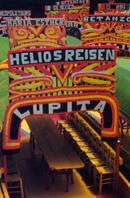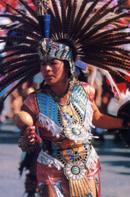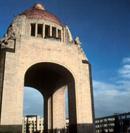MEXICO CITY A blend of Past and Present
Mexico City refuses to be labeled or branded. This is a colossal burg that brings up a variety of feelings among those who see it, yet it leaves nobody unscathed.
The impact of knowing a place like this for any traveler starts from the air. If your plane lands at night, when you look out the window you find an anarchic weaving of lights that give away the city's mammoth size.
The strength of its identity –curdled in the most unusual underpinnings of its history and oversized urbanization- make travelers fall head over heels with it and strain at its singularities rather than the flaws that abound in any of the world's huge towns.
Penciled in as one of the oldest, biggest and most astonishing metropolises of the Americas, today Mexico City also ranks as the country's major financial, political and cultural hub, let alone the peerless cultural treasures it cherishes from its pre-Hispanic, colonial and contemporary past.
Its cultural wealth is by and large the one element that puts the city up to par with other capitals in Europe, Asia and the Far East, and makes people downplay its traffic gridlock and the bad case of overpopulation. Mexico City grew right on the same spot that gave rise to one of the mightiest civilizations of the Old World –the Aztecs- whose rule spilled over all around from mythical Tenochtitlan.
From its very foundation circa 1325, this has been a different city because the Aztec-origin tribe that built it had decided to lay the first stone near the Texcoco Lake, a challenge that forced them to use very unusual constructive formulas. As the population grew, the lake was getting dotted by floating islands built by the residents who used soil-filled wicker rafts.
Only dregs of the majestic Aztec empire remain standing today. During the Spanish colonization led by Hernan Cortes, the new capital –named New Spain- was then built over the ruins of ransacked Tenochtitlan, a town that had been raged by battles, epidemics and a four-month siege staged by the colonizing troops.
Today, countless archeological sites, city museums and nearby locations speak volumes of the Aztecs' political and military mightiness, as well as the features of such long gone pre-Hispanic civilizations as the Mayans and the Olmecs that played a major role in the development of their own culture.
In over a hundred museums located in the metropolitan area, visitors can steal a look at an assortment of works and artifacts: pre-Hispanic samples, colonial paintings, baroque sculptures, murals by Mexican artists Diego Rivera and David Sequeiros, surreal works by Miro and Picasso, 17th-century footwear, 1914-vintage automobiles and jewelry.
El Zocalo Regardless of a multitude of choices, the citadel space is dominated by one particular place: El Zocalo, a giant square right in the heart of the city's historic core. Declared Heritage of Mankind by UNESCO, El Zocalo has witnessed numerous expressions of happiness and discontent aired by the Mexican people through the years. Among the world's largest plazas, El Zocalo ranks second only to Moscow's Red Square. Always jam-packed day in and day out, El Zocalo is the place where tourists can find a variety of shows ranging from makeshift stage performances and a rock concerts to the headquarters of social campaigns advocating for Indians' rights or to help HIV-infected people.
Every morning, the square is swarmed by street vendors who hawk junk food and all kinds of goods, either traditional items or imported gadgets. The National Palace, the Metropolitan Cathedral and the Higher Temple are three of the outstanding buildings around. With a strength similar to that of its population that leapfrogged from one million to a staggering 24 million people in just three quarters of a century, tourists have also flocked to the oldest urban center of the Western Hemisphere. Suffice it to say that ten million vacationers visited Mexico City just last year.
Known plainly by its residents as DF –a Spanish acronym meaning Federal District- the city holds preferences for everyone; it meets both the refined demands of the most sophisticated travelers and the much humbler interest of those who seek to take back home a piece of Mexico in their bags and minds, including handicrafts and mom-and-pop eateries serving countless dishes cooked from a wide variety of local recipes.
Any corner in town features a taco outlet, a stuffed roll that joins tequila as the two standard bearers of Mexican food around the globe. In a country labeled by scholars as one of the world's corn centers, maize is the cornerstone of scores of dishes, including tacos that are made out of a small tortilla stuffed with a variety of meats and vegetables, sprinkled with the red hot chili that Mexicans put in their mouths at an early age, an then rolled into a solid mass.
The Federal District's eclecticism allows dwellers to get the best of two worlds: high-tech skyscrapers on the one hand, like the recently opened Torre Mayor –Latin America's tallest building- and remainders of the colonial rule on the other. According to several polls, local residents have picked the Palace of Fine Arts, built in Carrara marble and host of the National Folkloric Dance Company, as the city's most gorgeous building.
Across the board, Mexico City is no doubt the heart of pre-Hispanic, colonial and modern Mexico. It's not the baroque thing about it, but the heart-throbbing poetry that erupts from each and every resident as a tribute to the Mexican homeland.Conquistadors come aboard When conquistador Hernan Cortes and his 400 henchmen landed in Mexico on November 8, 1519, they were reportedly flabbergasted by the lavishness of Tenochtitlan, an ancient town that was soon targeted as their primary goal. These were the remarks uttered by one of Cortes' soldiers:
“We had such wonderful sights that we reached our wits' ends. We didn't know if that was real. Canoes filled the lake and walkways stretched from bank to bank. Far from the distance, the great Mexico City was glimmering.”
At the onset, Aztec emperor Moctezuma II met with Cortes and showered him with presents, putting no hurdles to his entering the city. The superstitious emperor took the white-skinned, golden-hair, bearded Spanish conquistador for Quetzalcoatl, the great feathered snake god that, according to the tragic and ironic prophecy, was supposed to come from the East on the Year One of the Reed (Ce Acatl) to rule on the face of the earth.
In the Aztec calendar, the year 1519 matched that date. Therefore, Moctezuma welcomed the foreigner with open arms, giving him golden gifts and providing lodging for him in the royal palace. That mix-up brought on the downfall of the emperor as Spaniards took him in and launched out a bloody massacre all over Tenochtitlan that lasted almost two years.
Afterwards, Moctezuma was stoned to death during a riot staged by his followers against the Spaniards and died on June 30, 1520. That day went down in history as The Sad Night and Cortes was expelled from Tenochtitlan. Many Spanish soldiers rushed out of town carrying the stolen gold and soon drowned in the Texcoco Lake as their overburdened ships capsized. The story goes that Cortes rested under a huge tree in the town of Tacuba as he beat a retreat and wept his eyes out in despair for the loss.
The standing rest of that tree has turned out to be some kind of “urban legend” in bustling Mexico City. Cuauhtemoc, Moctezuma's 26-year-old cousin, took over as emperor and led the Aztecs into the final battles and the four-month blockade that decimated the population with a deadly load of hunger, thirst and unknown diseases. The Aztec city fell eventually into Spanish hands. On August 13, 1521, the once powerful Aztec Empire collapsed and Cuauhtemoc was captured in the siege of the Church of Conception near Tlatelolco.
Cortes builds the capital of New Spain Cortes and his men built the new colonial capital they called New Spain over the ruins of the rundown Aztec city. They used the huge stones of the imperial palaces to put up their own temples, churches and public buildings. When Spaniards first came in 1519, Tenochtitlan was a whole lot bigger than any European city at the time. The population was in the neighborhood of 300,000 inhabitants.
Some 40 years later, that same population had dwindled to a meager 75,000 people. During the time of the colonial rule, Mexico City expanded over the sophisticated grid-like outlay designed by the Aztecs. The city, though, acquired a Spanish look of its own with the addition of European and Moorish architecture. Franciscans and Dominicans pushed the word of gospel among Indians, thus giving birth to an interesting blend of traditions and ceremonies that have outlived the passage of time. The city's original residents mixed their blood with Spaniards and half-breeds were born. People with this combination of Indian and Spanish genes make up the largest chunk of Mexico's current population.
San Angel and Coyoacan: colonial enclaves To the southernmost end of Mexico City, travelers find San Angel and Coyoacan. Formerly, these were two separate ports lying in the outskirts of town, yet they're now part of the nation's capital with very distinctive features of their own. Here, the narrow cobblestone streets swerve into a maze of high-wall colonial houses, huge parks and squares decked out with fine-looking fountains.
Back in the 16th century, Hernan Cortes and his armies conquered the old city of Tenochtitlan and settled down in Coyoacan. The streets and patios still reveal some traces of the past that link them with enormous farms and monasteries. Coyoacan now affects the ruins of formerly majestic houses and mansions. To the west of Coyoacan, San Angel stands tall with similar features. During the colonial rule, this area lured scores of well-off Spaniards who liked the balmy weather and the perfect rural environment for their estates and summertime getaways.
Many of Mexico's outstanding political, artistic and literary figures have lived in both San Angel and Coyoacan. Besides Cortes himself, the two places were also home to Malinche –Cortes' lover and Indian translator- and lots of Spanish viceroys, let alone emperor Maximiliano and his wife Carlota. Among the top contemporary personalities that have called these two locations home are King Carol of Rumania, actress Dolores del Rio, Leon Trotsky, muralist Diego Rivera, artist Frida Kahlo and Jose Luis Cuevas. The residences of Trotsky, Rivera and Khalo have been turned into museums.
Another sightseeing site is the Diego Rivera and Frida Khalo House and Museum. The former residence and studio is teeming with the artists' personal belongings: brushes, paintings, letters, photos of friends and a lively collection of Judas carved in solid cardboard representing evilness.
Coyoacan –the word means The Land of Coyotes in Indian tongue- still shines with the charm of an old town. Every Saturday and Sunday, its two main plazas –the Centennial Garden and the Hidalgo Garden- come apart at the seams with peddlers, pantomimes, music buffs, poets, artists and clowns. One of the must-sees around here is the Frida Khalo Museum, the house where the famous artists was born and died in, and the National Museum of People's Arts, a place where Mexican traditions are at their best.






































































